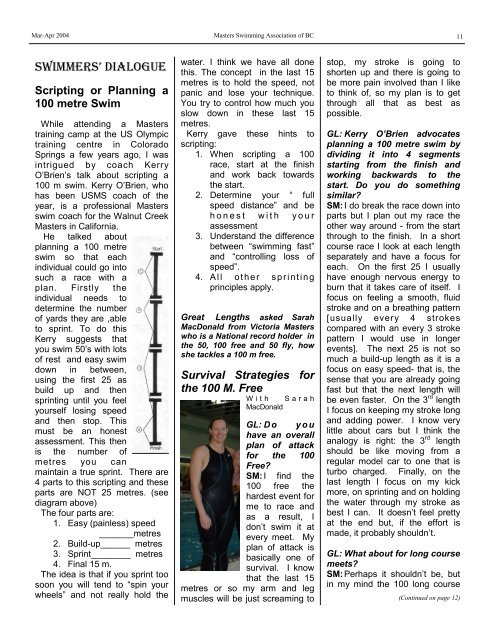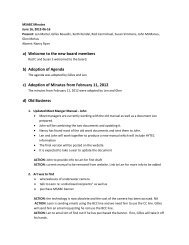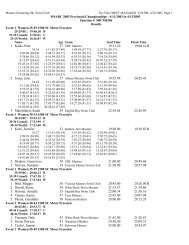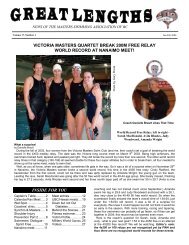Great Lengths - Masters Swimming Association of British Columbia
Great Lengths - Masters Swimming Association of British Columbia
Great Lengths - Masters Swimming Association of British Columbia
You also want an ePaper? Increase the reach of your titles
YUMPU automatically turns print PDFs into web optimized ePapers that Google loves.
Mar-Apr 2004<br />
<strong>Masters</strong> <strong>Swimming</strong> <strong>Association</strong> <strong>of</strong> BC 11<br />
SWIMMERS’ DIALOGUE<br />
Scripting or Planning a<br />
100 metre Swim<br />
While attending a <strong>Masters</strong><br />
training camp at the US Olympic<br />
training centre in Colorado<br />
Springs a few years ago, I was<br />
intrigued by coach Kerry<br />
O’Brien’s talk about scripting a<br />
100 m swim. Kerry O’Brien, who<br />
has been USMS coach <strong>of</strong> the<br />
year, is a pr<strong>of</strong>essional <strong>Masters</strong><br />
swim coach for the Walnut Creek<br />
<strong>Masters</strong> in California.<br />
He talked about<br />
planning a 100 metre<br />
swim so that each<br />
individual could go into<br />
such a race with a<br />
plan. Firstly the<br />
individual needs to<br />
determine the number<br />
<strong>of</strong> yards they are ,able<br />
to sprint. To do this<br />
Kerry suggests that<br />
you swim 50’s with lots<br />
<strong>of</strong> rest and easy swim<br />
down in between,<br />
using the first 25 as<br />
build up and then<br />
sprinting until you feel<br />
yourself losing speed<br />
and then stop. This<br />
must be an honest<br />
assessment. This then<br />
is the number <strong>of</strong><br />
metres you can<br />
maintain a true sprint. There are<br />
4 parts to this scripting and these<br />
parts are NOT 25 metres. (see<br />
diagram above)<br />
The four parts are:<br />
1. Easy (painless) speed<br />
_______metres<br />
2. Build-up______ metres<br />
3. Sprint________ metres<br />
4. Final 15 m.<br />
The idea is that if you sprint too<br />
soon you will tend to “spin your<br />
wheels” and not really hold the<br />
water. I think we have all done<br />
this. The concept in the last 15<br />
metres is to hold the speed, not<br />
panic and lose your technique.<br />
You try to control how much you<br />
slow down in these last 15<br />
metres.<br />
Kerry gave these hints to<br />
scripting:<br />
1. When scripting a 100<br />
race, start at the finish<br />
and work back towards<br />
the start.<br />
2. Determine your “ full<br />
speed distance” and be<br />
honest with your<br />
assessment<br />
3. Understand the difference<br />
between “swimming fast”<br />
and “controlling loss <strong>of</strong><br />
speed”.<br />
4. All other sprinting<br />
principles apply.<br />
<strong>Great</strong> <strong>Lengths</strong> asked Sarah<br />
MacDonald from Victoria <strong>Masters</strong><br />
who is a National record holder in<br />
the 50, 100 free and 50 fly, how<br />
she tackles a 100 m free.<br />
Survival Strategies for<br />
the 100 M. Free<br />
With Sarah<br />
MacDonald<br />
GL: D o y o u<br />
have an overall<br />
plan <strong>of</strong> attack<br />
for the 100<br />
Free?<br />
SM: I find the<br />
100 free the<br />
hardest event for<br />
me to race and<br />
as a result, I<br />
don’t swim it at<br />
every meet. My<br />
plan <strong>of</strong> attack is<br />
basically one <strong>of</strong><br />
survival. I know<br />
that the last 15<br />
metres or so my arm and leg<br />
muscles will be just screaming to<br />
stop, my stroke is going to<br />
shorten up and there is going to<br />
be more pain involved than I like<br />
to think <strong>of</strong>, so my plan is to get<br />
through all that as best as<br />
possible.<br />
GL: Kerry O’Brien advocates<br />
planning a 100 metre swim by<br />
dividing it into 4 segments<br />
starting from the finish and<br />
working backwards to the<br />
start. Do you do something<br />
similar?<br />
SM: I do break the race down into<br />
parts but I plan out my race the<br />
other way around - from the start<br />
through to the finish. In a short<br />
course race I look at each length<br />
separately and have a focus for<br />
each. On the first 25 I usually<br />
have enough nervous energy to<br />
burn that it takes care <strong>of</strong> itself. I<br />
focus on feeling a smooth, fluid<br />
stroke and on a breathing pattern<br />
[usually every 4 strokes<br />
compared with an every 3 stroke<br />
pattern I would use in longer<br />
events]. The next 25 is not so<br />
much a build-up length as it is a<br />
focus on easy speed- that is, the<br />
sense that you are already going<br />
fast but that the next length will<br />
be even faster. On the 3 rd length<br />
I focus on keeping my stroke long<br />
and adding power. I know very<br />
little about cars but I think the<br />
analogy is right: the 3 rd length<br />
should be like moving from a<br />
regular model car to one that is<br />
turbo charged. Finally, on the<br />
last length I focus on my kick<br />
more, on sprinting and on holding<br />
the water through my stroke as<br />
best I can. It doesn’t feel pretty<br />
at the end but, if the effort is<br />
made, it probably shouldn’t.<br />
GL: What about for long course<br />
meets?<br />
SM: Perhaps it shouldn’t be, but<br />
in my mind the 100 long course<br />
(Continued on page 12)










